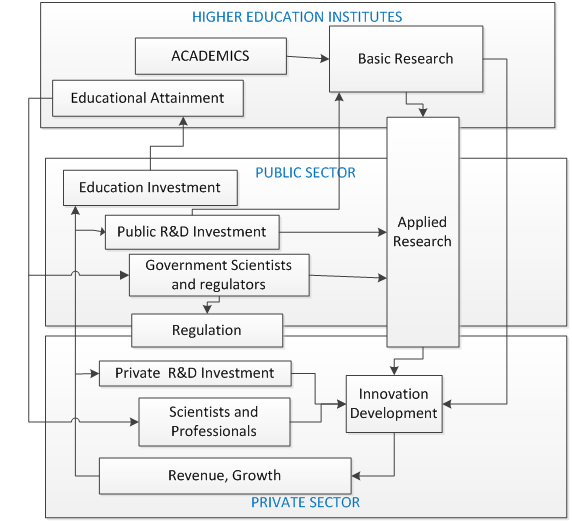International Futures Help System
Knowledge Systems
Overview
Knowledge and innovation are important drivers of economic growth and human well-being. These activities also help societies address major social and environmental challenges. Education and research and a linear relationship between these and product development are no longer considered a good model of knowledge and innovation systems. However, the linear model was the first successful attempt (Bush, V, 1945) in conceptualizing the science, technology and innovation (STI) activities. One of the major contributions of these first models was the distinction between basic and applied researches and the identification of stakeholders and funding for each type as shown in the next figure.

The failure of the linear model to capture the intricacies and interactions involved in the innovation process and the broader role of the public and private institutions and individuals in facilitating creation and diffusion of knowledge prompted some experts to resort to rich qualitative description of so called “national systems of innovation” starting from late 1980s, early 1990s. Increased educational attainment, fast expansion of information and communication technologies, more sophisticated production technologies and an expansion in the exchange of goods, ideas and people over the last few decades tell of something broader than just innovation constrained within national boundaries. Recent literature (citation) use concepts like knowledge economy or knowledge society to describe the systemic nature and impact of knowledge-intensive activities.
This new literature takes an evolutionary perspective and talks about a gradual unfolding of knowledge and innovation system (citation: Nelson, Freeman etc) within a country marked by a certain types of actors, institutions and organizations and the linkages across and within such components. Studies in this area range from more focused concepts of knowledge economy (citation: WB; OECD) to a broader knowledge society (citation: UNESCO; Bell), from a more qualitative innovation systems approach (citation: Nelson; Freeman) to a measurement focused innovation capacity approach (citation: GII Dutta, Archibucchi..). The complementarity of the components of such a system demands that the components be studied together. Accordingly, experts have come up with composite indices for assessing the knowledge and innovation capacities of countries around the world. Such indices give a good idea of the overall status of the innovation capacities of the country and the stage of knowledge society it is in. The components of the composite indices are categorized across four to five major dimensions (or, pillars, as some studies call these), for example, education and skills, information infrastructure, institutional regime, innovation activities (WB Knowledge Index etc).
International Futures (IFs) Knowledge module builds on other knowledge systems measurement approaches (cite WB KEI here) by designing a composite knowledge index (KNTOTALINDEX) comprised of five sub-indices containing a total of (x) components. The indices and the sub-indices are then forecast over the entire IFs’ horizon by combining the components which are themselves forecast through different modules of the integrated IFs model. To our knowledge, IFs is the only model capable of making such an organic forecast of the knowledge capacity of a country.
For more, please click on the links below.
- IFs Knowledge Indices
- Knowledge Systems Equations: Total Knowledge Index
- Knowledge Systems Equations: Knowledge Sub-Indices
 International Futures at the Pardee Center
International Futures at the Pardee Center